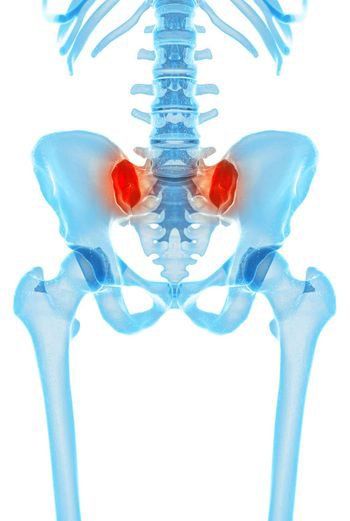Book an appointment call (904) 541-6144 or fill out the contact form
here
Sacroiliac Joint Dysfunction
Sacroiliac Joint Pain and Dysfunction in Jacksonville, FL
Lower back pain is a common health complaint among Americans today.
In fact, up to 80 percent of the population at one time or another suffers from lower back pain. However, out of this 80 percent a distinct 15 to 25 percent suffers from a condition known as Sacroiliac Joint Dysfunction, or SJD. As its name implies, this condition afflicts the sacroiliac joint(s) in the lower back, more specifically in the pelvic girdle, and results in lower back pain that can be disruptive and even debilitating. You can discover if you are at risk or already suffering from SJD by learning more about this unique joint structure in your back and how it can develop this painful yet treatable condition.
Locating the Sacroiliac Joints in Your Body
As you may know, your spinal column is made up of vertebrae, tendons, ligaments, discs, and nerves. The bones that comprise the joints at the lower most point in your spine are known as the sacroiliac joints. If you are familiar with anatomical terminology, you would know that the sacrum and the ilium are located in your pelvis.
This joint then lies at the base of the ilium, which is your large, flat pelvic bone, and the sacrum, which is a bone that looks like an upside down triangle and is located at the base of your spine. The joint makes itself visible on the outside of your body with two dimples that you may be able to see right below your belt line.
This joint is more or less a bundle of thickened ligaments and nerves. It is designed to absorb the shock and movement like gliding, tilting, and rotating associated with your everyday activities. It is also capable of stretching and accommodating the weight a woman carries during pregnancy. During childbirth, this joint will stretch even more to allow the baby to pass through the birth canal. Overall, this joint exists to help relieve the hips and spine of excess pressure and weight.
This joint then lies at the base of the ilium, which is your large, flat pelvic bone, and the sacrum, which is a bone that looks like an upside down triangle and is located at the base of your spine. The joint makes itself visible on the outside of your body with two dimples that you may be able to see right below your belt line.
This joint is more or less a bundle of thickened ligaments and nerves. It is designed to absorb the shock and movement like gliding, tilting, and rotating associated with your everyday activities. It is also capable of stretching and accommodating the weight a woman carries during pregnancy. During childbirth, this joint will stretch even more to allow the baby to pass through the birth canal. Overall, this joint exists to help relieve the hips and spine of excess pressure and weight.
Risk Factors and Symptoms of Sacroiliac Joint Dysfunction
As durable as this joint is, it also can succumb to damages incurred during the course of your everyday routine. The symptoms of SJD mimic those found with other lower back conditions like osteoarthritis, herniated discs, and other diseases that afflict the lower back area. Nonetheless, some of the more common symptoms associated with SJD include moderate to severe lower back discomfort, pain that goes into the upper leg or buttocks, or pain that is made worse when you move or try to lift heavy objects.
Many times, SJD results because of a direct injury to the area, such as when you slip and fall on ice or on a wet floor. However, this condition can also be the result of pregnancy or an illness. It can be exacerbated by inactivity and by excessive weight gain.
Some Factors Can Contribute to SJD include...
- Pregnancy
- Injuries from Falls
- Sports Injuries
- Car Accidents
- Pelvic Infections
- Vertebral Fractures or Dislocations
- Inflammatory Arthritis
- Uneven gait, such as when one leg is longer than the other
Diagnosing and Treating Sacroiliac Joint Dysfunction
Despite being the result of factors that may fall beyond the scope of your control, you can still seek out medical or chiropractic treatment for the pain and discomfort of SJD. Before you can be treated for it, you must first be properly diagnosed with the condition. It is no secret in the chiropractic industry that diagnosing SJD can in and of itself be a unique challenge. This joint condition mimics different types of arthritis and bone conditions, making it difficult to distinguish from other injuries and illnesses that commonly afflict the lower back area.
Still, your Jacksonville Florida chiropractor may use a number of different tests to determine if you genuine suffer from SJD. Your provider may perform a thorough physical examination during which he or she may will inspect the full range of your lower spine and monitor your pain level in the area. You may be asked to move and flex in various directions to determine your joint's response to stress and tension. Your provider might also use anesthetic blocks, which involves numbing the joint to determine if the pain you experience dissipates or lingers in another part of your spine. The use of anesthetic block is generally regarded as a secondary attempt to diagnose SJD, however. Likewise, chiropractors also will typically avoid using x-rays or MRIs, as these tests likewise provide inconclusive results.
Some Treatment Options Include...
- Therapeutic Massage
- Chiropractic Manipulation of the Joint Structure
- Therapeutic Exercises
- Dietary & Activity Modifications to Help You Gain Strength in your Sacroiliac Joint
- Gait Modification to help you bear weight and move your lower extremities properly
- Cortisone or Anesthetic Injections to reduce pain (in rare cases)
- Radiofrequency Denervation (destroying the nerves in joint)

